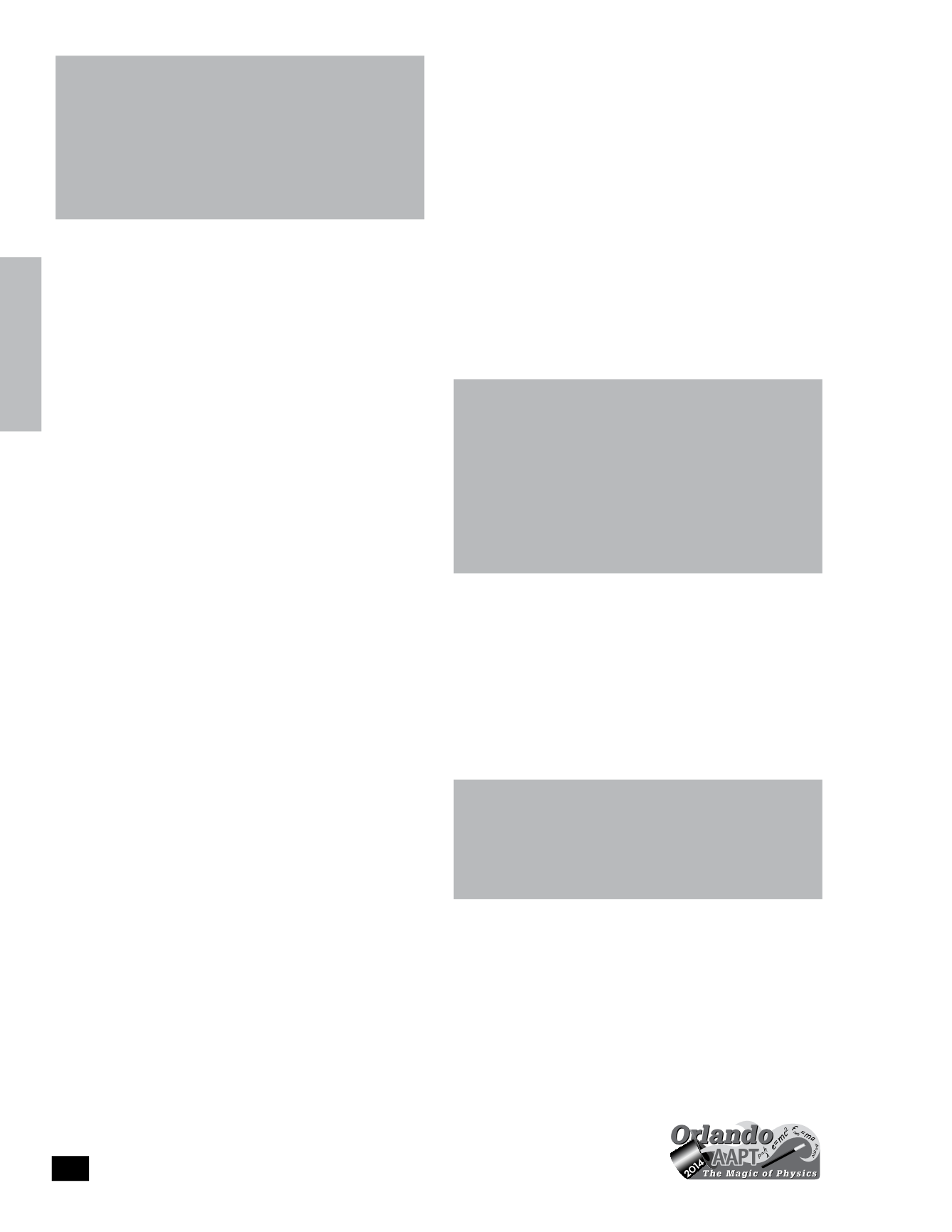
62
Monday morning
Session CC: Recruiting and
Retaining Physics Students II
Location: Salon 7
Sponsor: AAPT
Date: Monday, January 6
Time: 11 a.m.–12 p.m.
Presider: Kathleen Falconer
CC01:
11-11:30 a.m. Increasing Physics Enrollments by
Targeting Underrepresented Minorities
Invited – Jesus Pando, DePaul University, Chicago, IL 60614; jpando@
depaul.edu
Underrepresented minorities (URM) such as African-Americans,
Hispanics, and Native Americans collectively accounted for less then
10% of physics bachelor’s degrees in 2010 (NSF data). These groups
comprised 32% of the population in 2010 and predictions indicate
that this percentage will increase. There appears to be an untapped
pool of students among these groups from which to recruit into phys-
ics programs. Yet despite repeated efforts over the last 20 years, the
percentage of URM students in physics is little changed. This talk will
outline some of the reasons why previous efforts have failed by iden-
tifying in broad terms, some of the characteristics of URM students
that these programs have not addressed. Examples of programs that
have addressed some of the unique issues the URM students bring
to the table and hence, successfully attracted URM students, will be
discussed.
CC02:
11:30–11:40 a.m. Step Up to Physical Science and
Engineering at Randolph (SUPER)*
Contributed – Peter A. Sheldon, Randolph College, Lynchburg, VA
24503;
With the help of a National Science Foundation S-STEM grant, we
have instituted a recruitment and retention plan to increase the
number of physical science majors at Randolph College (total 600
students). While the grant provides scholarships to two cohorts of 12
students, our goal is to recruit 24 students each year into the physical
sciences, and to retain them at a higher rate than the college as a
whole. For three years prior to receiving the grant, we instituted some
parts of the program, and we currently have four senior physics ma-
jors, nine juniors, and eleven sophomores, compared to our historical
average of 2.7 physics majors/year. As well as an active recruitment
program, we have a summer transition program, an industry mentor
program, enhanced tutoring, a first-year seminar, and many start
research early. In this presentation, I will elaborate on these programs,
and discuss how we got it done.
*This project is supported by the National Science Foundation under Grant No.
DUE-1153997. Any opinions, findings, and conclusions or recommendations
expressed in this material are those of the author(s) and do not necessarily
reflect the views of the National Science Foundation.
CC03:
11:40-11:50 a.m. Designing a Physics Major at an
All-Women’s College
Contributed – Jolene L. Johnson, St. Catherine University, St. Paul, MN
55105;
Erick Agrimson, Kaye Smith, St. Catherine University
St. Catherine University is a small women’s liberal arts college in the
upper Midwest. We have not a physics major in the past for a variety
of reasons, but are considering adding a physics major. Our physics
program will incorporate some traditional classes taught in innovative
ways along with a large number of non-traditional innovative classes
that are project based and designed to increase student retention
and prepare them for future education or jobs. A few classes we are
exploring include a robotics class, a study abroad service learning
engineering project and biophysics. In this talk we will outline our
proposed major and the research we have conducted to design our
major. It is our hope that this major will increase the number of
women expressing an interest in majoring in physics and retention of
these students.
CC04:
11:50 a.m.-12 p.m. Authentic Research in the
Undergraduate Curriculum at Austin College
Contributed – Andra Troncalli, Austin College, Department of Physics,
Sherman, TX 75090;
David Baker, Don Salisbury, Peter Hyland, Austin College
At Austin College, we believe that students learn physics best by doing
physics. What better opportunity for our students to do physics and
be active participants in their learning than by conducting authentic
scientific research? Our physics majors (minors) are required to take
two (one) of our “Research Experience in Physics” courses. Students
work in small groups on independent research projects under the
supervision of a faculty member. Research areas match the faculty
members’ expertise and interests, which include superconductivity,
cosmology, weather, and observational astronomy. We will present
recent research investigations and discuss the benefits of these courses
both to our current students and to our graduates.
Session CD: Panel – Goals and
Assessment Tools for Instructional
Labs
Location: Salon 5
Sponsor: Committee on Laboratories
Co-Sponsor: Committee on Research in Physics Education
Date: Monday, January 6
Time: 11 a.m.–12 p.m.
Presider: Mark Masters
This panel will discuss both the goals of instructional labs
and how we assess the achievement of those goals. It is criti-
cal that we understand that there are a variety of goals in
laboratory. However, we need to have mechanisms to assess
the success of these goals, whatever they may be. The panel
will present their goals and describe assessment methods.
The forum will then be opened up to the floor in hopes that a
lively debate will ensue, as might be expected anytime some-
one mentions the four letter word known as “assessment” in
polite company.
Session CF: Introductory Courses
Location: Salon 9
Date: Monday, January 6
Time: 11–11:30 a.m.
Presider: Dyan Jones
CF01:
11-11:10 a.m. Student Use of Office Hours: An
Exploratory Survey-based Study
Contributed – Kristen M. Burson, Gettysburg College, Gettysburg, PA
17325-1486;
Whitney Griffin, University of Maryland - College Park
Office hours provide an opportunity for student-faculty interaction,
one key benchmark of student engagement. Yet this potential goes
unrealized if students do not show up, or feel uncomfortable. Here
we present and analyze the results from a survey of undergradu-
ate students at a large, public mid-Atlantic research university that
captured the factors influencing their attendance of office hours. With
our results and analysis, we shed light not only on those factors that


